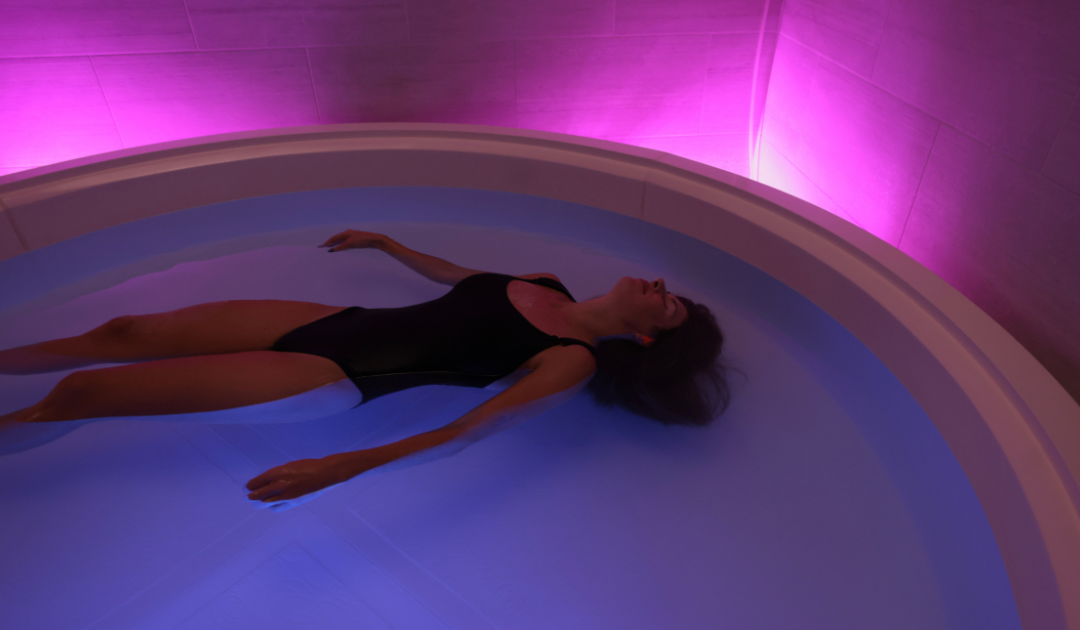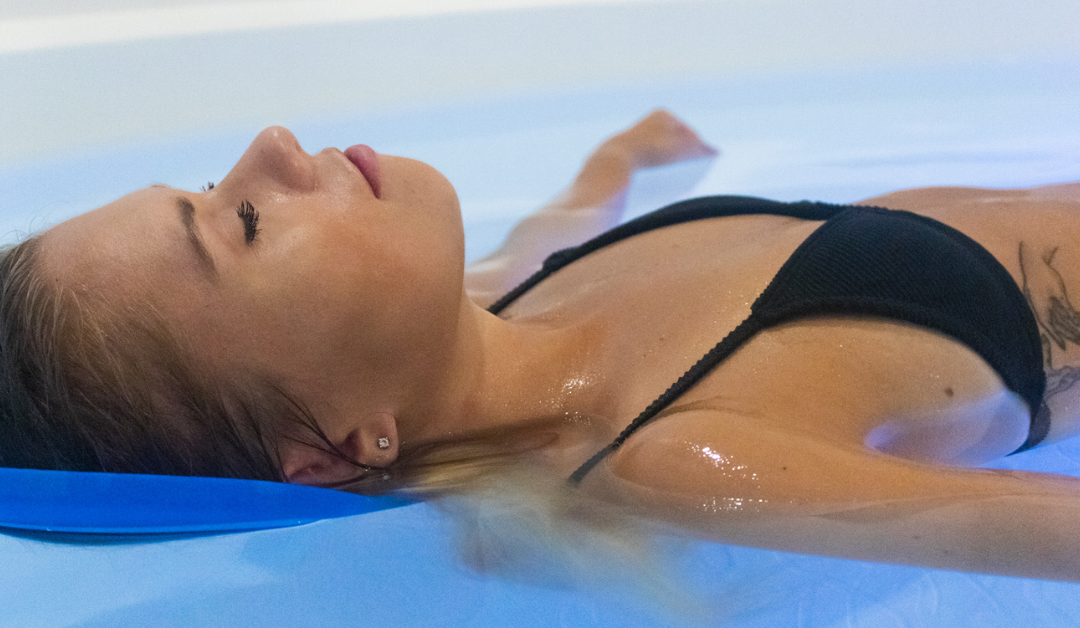
by Float Milwaukee | Jan 16, 2023 | Featured, Physical Health
If you’re anything like us, you always look for new ways to relax and de-stress. When it feels like so much is happening around us, finding the time and motivation to take a break can be challenging. And float therapy is one of the best ways to put your mind at ease.
Float therapy pools and pods are sometimes referred to as sensory deprivation. They involve lying in a shallow pool of warm salt water, allowing most external stimuli to disappear.
Floating leads to an incredibly peaceful state that helps alleviate stress and anxiety while providing a sense of mental clarity. Think of it as an hour of zen.
It’s completely normal to be weary about new things, especially when water is involved. So is it possible to drown in a float therapy tank? And what are float therapy sessions like?
Can you drown in a float therapy tank?
The truth is any water can be dangerous for humans; however, it’s nearly impossible to drown in a float tank. Your body is cushioned and supported (a.k.a. floating) in the water by the 900+ pounds of Epsom salt. Like a memory foam mattress, your body makes a slight imprint in the water without actually coming in contact with the bottom.
And if you’re worried about falling asleep and potentially turning over, don’t be!
Turning over in the float therapy tank is extremely difficult, even when trying. Because of the buoyancy, your body is cradled and prevented from turning side to side.
Believe it or not, sleeping in float tanks brings a sense of relief and relaxation. Here at Float Milwaukee, we regularly offer a service called overnight floating where clients arrive in the evening, and sleep the night away in the float tank.
While it sounds like you’ll end up like a prune with that much time in the water, your body is resistant to wrinkling because of the high salt content of the solution.
How is floating possible?
When you drop an ice cube into the water, it floats because the ice is less dense than water. In fact, a 440 million pound glacier will float in water, while a ten pound rock would sink. Epsom salt adds to the density of the water, making the liquid more dense than your body no matter how much you weigh. The salt dissolves entirely while adding enough mass to keep you afloat. So if you have a fear of water or cannot swim, floating can help put your mind at ease.
Aside from worrying about drowning, people may be concerned about feeling claustrophobic in the float tank due to its confined space and closing lid. It’s important to note that float therapy pods and pools provide ample room, enough for a person to stretch fully. The wide, carefully designed tanks ensure your comfort, as well as provide plenty of space for you to stretch, relax, and explore peace. The open pools do not have a lid that closes to help regulate temperature. Even with a closing lid, they are controlled by a hydraulic mechanism with the handle inside the pod that you can effortlessly push open with one hand. Both the pods and pools are completely secure as you enter into a private, locking room, so no one can enter your space.
What is floating like?
Floating is a one-of-a-kind experience that benefits everyone differently. While it’s often referred to as sensory deprivation, that term is technically misleading. Floating removes most stimulation and recalibrates your system. That’s why we like to describe it as sensory enhancement.
Floating reduces stress and anxiety, lowers blood pressure and heart rate, relieves aches and pains, improves sleep quality, increases creativity, and heightens awareness. Read more about the benefits of float therapy here.
Here’s how it works:
You get the option to choose a pod or pool, depending on the type of environment you’d like. For example, a pod allows you to shut yourself off from the world through a lid. Closing the lid helps maintain consistent temperature between air, water, and skin. This helps ensure a quicker and longer period of feeling like you are floating in space without the feel of water touching your skin.
On the other hand, the pool offers additional space and lower humidity. If you’re looking to stretch out and maximize your space like some of the athletes that come in, the pool is an excellent choice. Rather than a spherical pod, you’re in a circular pool without an enclosure.
And the best part? You have full control over lights and music in both. It’s a personalized experience that allows you to relax and float in your own serene environment. Both environments allow for total quiet and dark due to how the overall rooms are constructed.
From the moment you enter the water, it’s like a warm hug from the inside out. And as you adjust to the temperature, your muscles and breathing rate begin to relax — it’s truly a feeling like no other. Since everyone experiences float therapy differently, we recommend you go ahead and try your first floating experience!
Settle into serenity
Whether you’re looking for that moment of “eureka” or need an hour to escape our fast-paced world, floating is a great way to get away from everything and experience true relaxation. The tanks are designed for comfort and provide plenty of space to stretch out. And while we understand how water might be a concern, let us assure you it’s an incredibly safe and secure experience. With so many benefits, there’s no reason not to try float therapy! So go ahead, take the plunge, and experience floating for yourself.

by Float Milwaukee | Oct 20, 2020 | Physical Health
Astronauts talk about what it feels like to leave Earth’s gravity for the first time, something between euphoria and completely natural.
Given that we’re glued to the Earth’s surface, humans are hard-pressed to even understand such a weightless experience. But what if you could? Would you do it? What if such an experience was in your backyard (or just up the road)?
As it turns out, floating works like that. The increased buoyancy from the Epsom salt in the water creates a weightlessness similar to drifting in zero gravity (of course, it’s not a perfect simulation)! This helps those who float potentially reach that state of euphoria.
And when a person floats frequently, their body begins to exhibit the benefits. Some of the benefits are short term, while others serve the body for the long term.
So, if you’re ready to learn more, settle in with us because we’re going to highlight some of the biggest benefits to frequent floating.
Driving Back Chronic Pain
How does floating ease chronic pain? As it turns out, gravity is pretty hard on our bodies. When a person floats, pressure is taken off their ligaments, joints, and muscles. By reducing the pressure these parts of the body have a chance to loosen up and rest themselves. Since they don’t ask for breaks, floating is a great way to take the load off them and give your mind a chance to rest as well!
Chronic pain takes a toll on the body, as well as the mind. By choosing to float frequently both the mind and the body get to recharge.
Better Sleep
Fatigue and pain are some of the biggest reasons people lay awake at night. Since frequent floating relaxes the muscles, joints, and ligaments, sleep is more easily achieved. Floating helps your body wind-down and relax which is the perfect recipe for sleep to come easily.
What’s the reason for this wind-down effect? On top of a loosened body, floating encourages deep breathing, which prompts airways and blood vessels to open up. When the body is functioning the way it’s meant to, the natural recharging mechanisms work how they should.
Reduced Stress and Blood Pressure
The minerals in Epsom salt stimulate lower blood pressure. However, that’s not the only way it lowers stress and blood pressure. Being able to relax the mind stimulates a reduction in cortisol—the stress chemical our body creates.
Steady breathing, which lowers the heart rate + relaxation, which lowers cortisol + Epsom salt = an overall healthier body. That sounds like a pretty great deal, right?
Closing Thoughts
When you float often and consistently, you get to partake in the short term benefits like better sleep and lower stress. The long term benefits also stack up! Lower blood pressure over time, a better heart rate, and an overall more relaxed body is good for your longevity.*
Until then… we hope to see you around at Float Milwaukee!
*Floating CAN help alleviate symptoms and pain. Floating is NOT a cure for arthritis, inflammatory diseases, serious mental health disorders, heart disease, and other ailments. Make sure you see a doctor if you’re experiencing intense chronic pain, along with any abnormal symptoms or mental states.

by Float Milwaukee | Jan 27, 2020 | Physical Health
It’s true: people love to travel. There’s just something deep inside many of us that gives us an undeniable wanderlust. Whether it’s the drive to experience new things, a desire to return someplace you’ve loved, or just the whim to pick a direction and see what’s out there, most people feel that pull sooner or later.
Still, while travel can be an amazing adventure, it sometimes carries stress along with it. One of the most insidious and dreaded forms is the phenomenon known as “jet lag.” Or, the fatigue that comes from experiencing a significant shift in time zones. But even if you’re flying straight north or south without needing to reset your watch, tiredness from travel can be a real bear to deal with.
Let’s start with the time zone pickle. Domestically, the effects of traditional jet lag can be noticeable, but mild. If it’s noon in Los Angeles, it’s only 3 p.m. in New York. Usually, a quick coffee is all you really need in that case.
But what about international travel? That same noon in LA is 8 p.m. in London. 11 p.m. in Moscow. And in Tokyo and Sydney, it’s already tomorrow. So, whether traveling for business or leisure, adjusting to a completely different schedule can really cramp your traveling style.
Even staying within the same time zone is no guarantee you won’t de-plane pretty wrung out. It takes just as much time to fly from Miami to Toronto as it does to jet from Chicago to Las Vegas. So even though you’re not necessarily messing with your perception of the hour when you land, it can still be a pretty exhausting day of travel.
There are a lot of theories as to why travel tension happens, and how to alleviate it. Some health experts have suggested that extended time spent at elevated altitudes may be partially to blame. There’s even a school of thought gaining momentum that says strolling around barefoot in the local earth may help literally ground us, and “reset” certain electrical charges in the body.
Thankfully, there’s a significant range of evidence that indicates floating can be very effective in re-orienting your internal clock to promote improved restfulness. Since some studies suggest that an hour in a float tank can be equivalent to a 5-7 hours of sleep, many travelers report some success with using floatation therapy to “reboot” their topsy-turvy sleep schedules.
So…how does it work?
Sleep may be something we all do every night, but the science of how and why we sleep still holds many mysteries. However, one thing science does seem to agree on is that we all have a personal, interior set of sleep-regulating patterns referred to as “circadian rhythms.”
These rhythms are a complex set of deep-seated brain-wave patterns that govern when we sleep and how deeply. They can be affected by many things. Stress, diet, work schedules, habits, and – of course – travel all factor in to the maintenance (and/or disruption) of the circadian cycle.
And when this happens, many jet-setters swear by floating as a means of helping to “nudge” their sleep cycles back into a workable state.
Supermodel Elle MacPherson reportedly cites floating as the ideal way to keep herself in top runway-strutting shape no matter where she travels in the world. So does her friend and fellow model Jessica Hart, who touts tank time as a means of “resetting” her baseline sleep cycle, saying, “afterwards you feel super chilled and rejuvenated.”
Actress Naomie Harris agrees, having recently told Balance Magazine, ”I’ve discovered that the only way to combat the effects of traveling is to immerse myself in a dark pod, filled with salt water and float for an hour. It’s all about sensory deprivation and works a treat. I go straight there from the airport, but my dream is to have my own tank at home.”
Still not convinced? Health coach and wellness blogger Jenny Sansouci points to floating as the best way to beat the jet lag blahs, saying that “one of the most celebrated benefits of the float tank is getting deep, deep rest.”
“When I take a long international flight, I have a little jet lag trick that I use as often as possible: I book a session in a float tank immediately when I land at my destination. If I do a 60-90 minute float upon arrival, it always makes my body feel rested and rejuvenated from the long day (or days) of travel, and significantly reduces the recovery time I need to feel like myself again.”
Still need more? CNN recently listed floating as an effective jet lag therapy, alongside melatonin supplements, and Japanese water massage. They write:
“New treatments such as Restricted Environmental Stimulation Therapy (REST), also known as isolation tanks or flotation therapy, could also provide some perks for frequent travelers due to its ability to recalibrate your internal clock. In Europe, REST flotation tanks have been a popular practice since the 1980s. They are used for relaxation, encouraging creativity, and treating problems such as anxiety, swelling, insomnia and jet lag.”
Of course, none of this is to suggest that you NEED to have traveled recently in order to stop in to Float Milwaukee. Still trying to catch up on lost holiday sleep? Burning some midnight oil hours to make up for time off of work? Or are you still having a tough time adjusting to Daylight Saving Time messing with your schedule? Hey, we’ve got you covered. Just book a tank trip, and get the rest you need on a schedule.
And even if you’re headed out somewhere (as opposed to back home), we’d still suggest you find a float center upon arrival – especially if you’re traveling internationally. There are countless float centers around the world that would be more than happy to help you get your rest cycle back into shape, so you can better enjoy your trip.
And of course, the next time you step off a red-eye back home feeling a little bent up from dealing with cramped bathrooms, tight seats, and a stiff neck from fitful naps against the window, we’ll be happy to help you take a load off, and get back on your feet…fast.

by Float Milwaukee | Dec 16, 2019 | Physical Health
Ah, the miracle of life.
Pregnancy can be a magical time, to be sure. There’s just something extraordinary about growing a whole new human. Charting the progress, counting the days, preparing space in your home and your life…there’s nothing else quite like it.
Of course, it’s not all pastels and baby showers. It’s also swollen feet, aching backs, sore joints, and intense fatigue. Expectant moms are in for a lot of intense physical changes that can really take a toll on their body in the run-up to their bouncing bundle of joy’s arrival. To make matters worse, most OB/GYNs advise against pain relievers – even aspirin – during a pregnancy.
So, what’s a soon-to-be new mom to do?
You probably won’t be surprised to hear that Float Milwaukee has a really good suggestion!
“Can I float while pregnant?” is easily one of the top three questions we get asked. And the answer isn’t just that you CAN float while expecting, but that you really SHOULD.*
Here are five big reasons why:
1.) Floating is completely natural relief.
The list of things your care team (and other moms) say you aren’t supposed to do while pregnant is pretty daunting. Don’t eat sushi. Don’t paint. Don’t change the litter box. Don’t expose yourself to secondhand smoke. Don’t wear heels. Don’t drink coffee.
Well, what CAN I do?!?
You absolutely can float. Floating is a drug-free, no-side-effect, all-natural way to relax, de-stress and relieve pain and pressure on your body and mind. Most floaters report an increased sense of calm, improved well-being, and better sleep – all things that can be tough for expectant moms to come by sometimes.
(And sure, a lot of doctors will tell you to avoid hot tubs or saunas while baby is still busy getting ready. But because our tanks are kept at a neutral body temperature, those warnings don’t apply here.)
2.) Floating is sanitary.
A lot of the recommended pregnancy “don’ts” have been passed down out of concern for cleanliness. Concerns about coming into contact with any sort of impurities in the air, water, or environment turns a lot of moms-to-be into virtual hermits. Many doctors recommend you even avoid coloring your hair because of the chemical agents present in some methods!
But floating is completely safe for you, your body, and your baby.
Reason being, all the water in the tank is purified via a variety of redundant methods. Every drop is treated with UV light, and a hydrogen peroxide solution. Additionally, there are 900 pounds of dissolved Epsom salts in each tank. So the high salinization of the water inhibits most impurities and the peroxide and UV light takes care of the rest.
In a world of finger-wagging “don’t do thats” from well-meaning people, floating is one pregnancy indulgence you can permit yourself without worry.
3.) Floating negates gravity.
Gravity affects us all. But we never feel it more than when we’re literally carrying around a whole extra body in addition to our own.
The gradual, inevitable weight gain that accompanies pregnancy can really do a number on your spine, joints, and muscles. By the third trimester, even getting out of bed can be an effort.
Thankfully, floating can make all of that go away.
Floating is the one therapy that can completely eliminate the effects of gravity. The water is warmed to a level that matches your natural body temperature, and is heavily salinated…so by simply leaning back and letting go, your body is held in something close to suspended animation. You’re held up by a substance specifically designed not to be felt at all. In fact, many floaters describe the experience as being like “drifting in outer space.”
Just imagine – nothing pulling you down. No strain, no compression…only a feeling of stimulus-free calm as your entire body is supported by an invisible, undetectable cushion.
4.) Floating offers essential therapeutic benefit.
As with many essential nutrients and minerals your body needs, magnesium levels can drop during pregnancy.
This is especially worrying since magnesium is one of the most crucial minerals needed for optimal gestation. Key medical studies have shown that supplying the body with extra magnesium during pregnancy can help prevent low birth weight, and preeclampsia.
Additionally, transdermal absorption has been shown to provide your body with greater levels of more easily usable magnesium than oral ingestion.
Which is all just a fancy technical way of saying that the half-ton of dissolved magnesium citrate Epsom salts in each of our float tanks can do more to help your baby’s health than taking a pill with your morning water.
(Oh, and if you’ve ever taken an Epsom soak before, you know how amazing your skin feels afterward. That’s really just an added bonus.)
5.) Floating promotes prenatal bonding via the “Mirror Effect.”
Your baby is floating in total darkness, surrounded by a soft, temperature-neutral bath. All he or she hears is a heartbeat. All they know is calmness and peace.
Why not join them?
Every floater’s experience is different. Still, many moms-to-be talk about how floating helps them experience the same sort of quiet sensory neutrality their baby is. This can form an even stronger bond between moms and their little ones by simulating a shared experience.
Not to mention that because baby is sharing the same biological ecosystem as Mom, any serotonin, oxytocin, and/or endorphins floating may produce for her only result beneficial effects for everyone.
***
Certainly, we recommend floating for anyone experiencing stress, anxiety, chronic pain, and/or a whole host of issues. But clinical studies and customer experiences alike have more than demonstrated to us that pregnancy in particular is an ideal time to float.
*We’d also be remiss in not advising you to always speak with your doctor when entering into any new activity during pregnancy therapeutic or otherwise, and follow the advice of your care team.
So when you’re ready to shut off the pre-birth effects of pain, gravity, and unrest, feel free to drop by. Our friendly, helpful staff is always happy to offer tours, and answer any questions you may have.
See you (and your tiny passenger) soon!
– Your friends at Float






